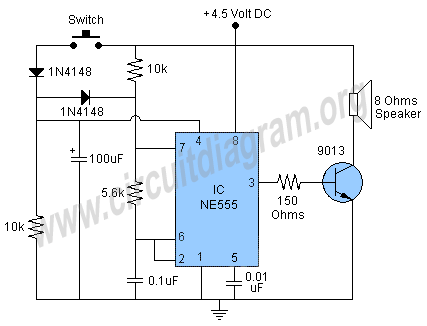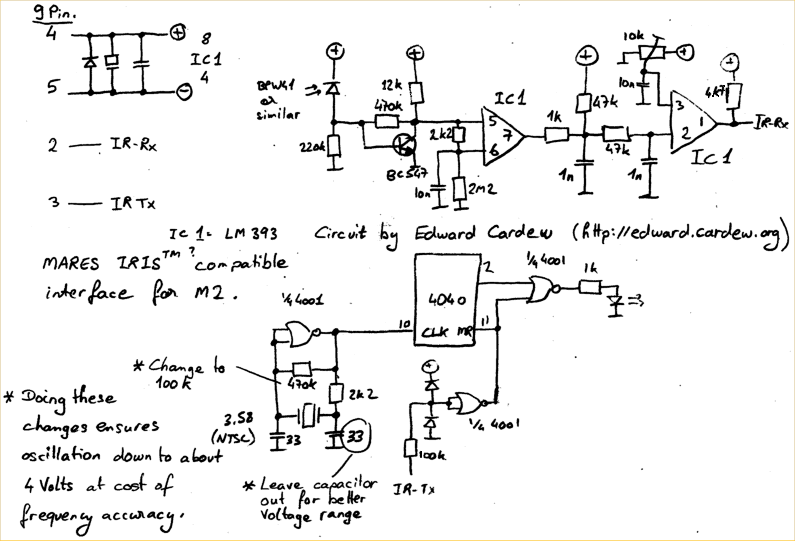
bell circuit

This project involves a ding-dong doorbell circuit utilizing the 555 Integrated Circuit (IC). In a previous article, a simple doorbell circuit using the UM66 IC, a CMOS three-terminal melody IC, was discussed. The current circuit employs the NE555 IC along with several other components to generate a doorbell sound. The frequency of the sound can be adjusted using 5.6kΩ and 10kΩ resistors. A 9013 transistor is used to amplify the output of the IC to drive an 8-ohm speaker. Alternative transistors can also be used in place of the 9013. The circuit produces a ding-dong bell sound when the switch near the 1N41418 diodes is pressed. The operating voltage for the circuit is 4.5 volts DC.
The circuit design begins with the NE555 timer configured in astable mode, which generates a square wave output at a frequency determined by the resistors and capacitors connected to its pins. The frequency of the sound produced can be modified by changing the values of the 5.6kΩ and 10kΩ resistors, allowing for customization of the doorbell tone.
The output from the NE555 IC is fed into the base of the 9013 transistor, which acts as a switch and amplifier. When the NE555 outputs a high signal, the transistor is turned on, allowing current to flow from the power supply through the 8-ohm speaker, thus producing sound. The choice of an 8-ohm speaker is crucial, as it is compatible with the output characteristics of the transistor, ensuring adequate sound levels.
The circuit includes a momentary push-button switch that, when pressed, triggers the NE555 IC to produce the sound. The inclusion of 1N41418 diodes in the circuit serves to protect the components from potential reverse voltage spikes that can occur when the speaker is energized and subsequently de-energized.
The overall operating voltage of the circuit is specified at 4.5 volts DC, which can be supplied by standard battery configurations or a regulated power supply. This low voltage operation makes the circuit suitable for battery-powered applications, enhancing its versatility for various doorbell installations.
In summary, this ding-dong doorbell circuit using the NE555 IC is a straightforward yet effective design, providing a customizable audio output for doorbell applications while ensuring reliability and ease of assembly.This is a project of a ding dong door bell circuit using 555 IC. In the previous article we have discussed about a simple doorbell circuit using UM66 IC which is a CMOS three terminal melody IC. The circuit mentioned here is using NE555 IC and few other components to create doorbell sound. The frequency of sound can be controlled with 5. 6k and 10k resistors. The transistor 9013 is used to amplify the output of IC to drive an 8 ohms speaker. You can also use substitute transistor in the place of 9013. The circuit will produce ding dong bell sound by pressing the switch near the 1N41418 diodes. The operating voltage of the circuit is 4. 5 volt DC. 🔗 External reference
The circuit design begins with the NE555 timer configured in astable mode, which generates a square wave output at a frequency determined by the resistors and capacitors connected to its pins. The frequency of the sound produced can be modified by changing the values of the 5.6kΩ and 10kΩ resistors, allowing for customization of the doorbell tone.
The output from the NE555 IC is fed into the base of the 9013 transistor, which acts as a switch and amplifier. When the NE555 outputs a high signal, the transistor is turned on, allowing current to flow from the power supply through the 8-ohm speaker, thus producing sound. The choice of an 8-ohm speaker is crucial, as it is compatible with the output characteristics of the transistor, ensuring adequate sound levels.
The circuit includes a momentary push-button switch that, when pressed, triggers the NE555 IC to produce the sound. The inclusion of 1N41418 diodes in the circuit serves to protect the components from potential reverse voltage spikes that can occur when the speaker is energized and subsequently de-energized.
The overall operating voltage of the circuit is specified at 4.5 volts DC, which can be supplied by standard battery configurations or a regulated power supply. This low voltage operation makes the circuit suitable for battery-powered applications, enhancing its versatility for various doorbell installations.
In summary, this ding-dong doorbell circuit using the NE555 IC is a straightforward yet effective design, providing a customizable audio output for doorbell applications while ensuring reliability and ease of assembly.This is a project of a ding dong door bell circuit using 555 IC. In the previous article we have discussed about a simple doorbell circuit using UM66 IC which is a CMOS three terminal melody IC. The circuit mentioned here is using NE555 IC and few other components to create doorbell sound. The frequency of sound can be controlled with 5. 6k and 10k resistors. The transistor 9013 is used to amplify the output of IC to drive an 8 ohms speaker. You can also use substitute transistor in the place of 9013. The circuit will produce ding dong bell sound by pressing the switch near the 1N41418 diodes. The operating voltage of the circuit is 4. 5 volt DC. 🔗 External reference





